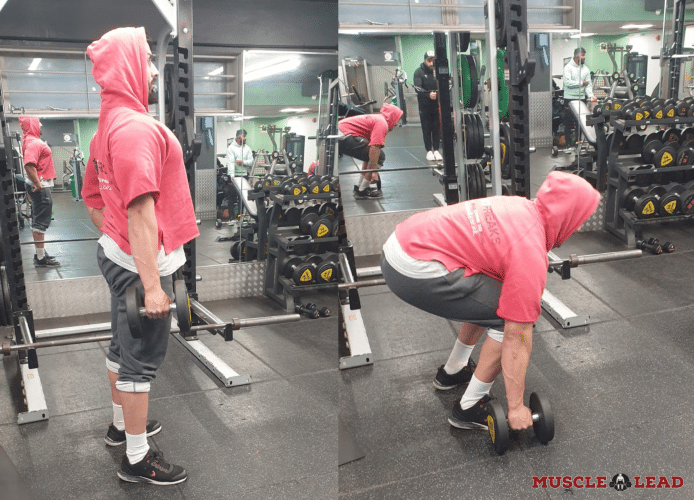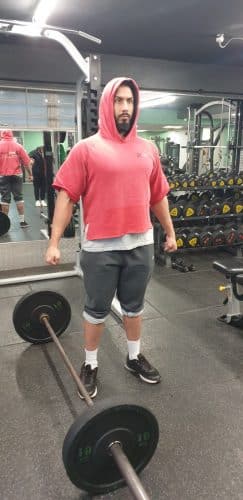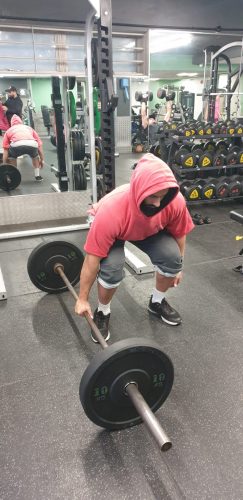Key Points
- Suitcase deadlift is literally lifting a vertically positioned barbell from the side of the body, as if you were lifting a suitcase.
- Seven different muscles are worked during the suitcase deadlift.
- It is recommended to perform suitcase deadlifts in the middle or end of the workout.
In this exercise guide, we have covered a very unique deadlift variant called the suitcase deadlift. We go over suitcase deadlift muscles worked, how to, benefits and alternatives.
So what is the suitcase deadlift? The suitcase deadlift muscles worked include your core, glutes, calves, grip strength, traps, hamstrings and quads. With the suitcase deadlift, you hold the weight on one side of your body and perform a regular deadlift. This movement mimics holding a suitcase and has great practical applications in everyday life.
Let’s go over the suitcase deadlift and determine if it’s perfect for your training program.
What is the Suitcase Deadlift?
The name of this deadlift variant is comical but makes perfect sense. Whoever came up with the name must have been the ultimate gym’s joker.
During the suitcase deadlift, you are literally lifting a vertically positioned barbell from the side of the body, as if you were lifting a suitcase or your mom’s groceries.

Suitcase Deadlift Muscles Worked
The muscles activated during the suitcase deadlift match the conventional deadlift.
This is a result of the same kinetic chain being involved in the movement.(3)
However, some of the muscles like the obliques may be targeted to a greater extent during the suitcase deadlift.
I have highlighted the 7 main suitcase deadlift muscles used in the movement.
1. Grip Strength Muscles
The suitcase deadlift is a unilateral movement.
As with a suitcase carry, this movement tests your grip strength. Your grip gets tested while statically holding your arm out.
In addition, balancing the barbell engages the muscles around the hand, wrist and forearm.
2. Calf Muscles
During the first part of pressing the feet against the ground, your calf muscles activate.
These include the gastrocnemius on the back of the lower leg, and the soleus on the outer side.
3. Quadriceps
While straightening the leg in the second movement of the lift, you activate the 4 muscles of the quadriceps.
These muscles include; vastus lateralis (outer thigh) vastus medialis (inner thigh), vastus intermedialis (middle thigh) and rectus femoris (deep middle thigh).
The rectus femoris of the quadriceps also helps during the hip movement while placing the bar back down.
4. Hamstrings
The hamstrings are the 3 stringy muscles on the back of the upper leg. These muscles go by the name of Bicep femoris (outer hamstrings), semitendinosus (middle hamstrings), and semimembranosus (inner hamstring).
These muscles come together to help in the hip straightening movement during the suitcase deadlift.
5. Gluteus
Gluteus is the thick butt muscles on the back of the upper leg.
This muscle helps hip movement during the suitcase deadlift. As with a conventional deadlift, the glutes get heavily involved to keep your back straight.
The one sided nature of the suitcase deadlift can help point out any weaknesses in hip movement and glutes.
6. Core Stability Muscle Groups
There are 8 main core stability muscles including; Diaphragm, Rectus Abdominis, Erector Spinae, Transversus Abdominis, Obliques, Pelvic Floor Muscles and Multifidus.
These muscles surround the midsection and kick in throughout the suitcase deadlift to help keep the spine straight and halt it from curving and getting injured.
Another property of this muscle group is to support balance, which is crucial during the suitcase deadlift. Without balance, the chances of toppling in the direction of the barbell.
7. Trapezius
One of the main back muscles involved at the last point of the movements would be the meaty part of the upper back known as the trapezius. This would be activated while shrugging the shoulders up.
How to Perform Suitcase Deadlift
I have included a 14 step guide to performing the suitcase deadlift. You can alternate between both sides of the body, if it suits your training program.
STEP 1: Find a clear space in the gym suitable for deadlifting. Use the squat rack.
STEP 2: Place an Olympic Barbell (with center knurling) on the floor.
STEP 3: Load the barbell depending on your training phase, i.e., 70% intensity x 10 reps x 3 sets (hypertrophy training). I load the barbell with a light weight for any new exercise.
STEP 4: Stand in with your side centered with the barbell. With the middle of the barbell incline with your outer lower leg.

STEP 5: Step away slightly and place the feet around hip width apart. With the feet pointed slightly outwards.
STEP 6: Grasp the barbell from the center knurling with a single arm. Balance it so you are stable and not toppling.
STEP 7: Drop the hips. Bend at the knees and shift your weight to your heels.

STEP 9: Take a deep breath with the intention of drawing the air towards the bottom of the stomach.
STEP 10: Brace the muscles on the trunk and the core in a 360° manner. Hold your breath.
STEP 11: Press from the ball of the foot while straightening the knee/hips.
STEP 13: Finish by bringing the weight up and shrugging the shoulder blade downwards. Then breathe out.
STEP 14: Drop the bar back to the starting point, then repeat the movement.
How To Breathe Properly During Deadlift
Benefits of Suitcase Deadlifts
The 5 benefits that I have discussed in greater detail below include:
- Grip Strength
- Asymmetric Strength
- Anti-bending Strength of Spine
- Real Life Transferability
- Improvising with Lower Loads
1. Grip Strength
Having to grip the barbell and then balance it during the lift would likely strengthen the grip muscles and wrist joint. This grip strength can be translated into many other lifts and sports.
2. Asymmetric Strength
The suitcase deadlift would strengthen the side of the body that the weight is being lifted from. Generally, it is suggested to alternate between each side of the body so that you do not pick up any muscle imbalances.
However, if you find that one side of the body is more dominant, you could prioritize the weaker side with the suitcase deadlift to fix any asymmetries.(1)
In turn, this could prove to be useful during lifts where it is crucial to draw symmetrical leg and hip hinge strength. For example, the conventional barbell deadlift, barbell squats, and even the barbell bench press.
Sumo Deadlift vs Conventional Deadlift – Which is Better?
3. Anti-rotation Strength of Spine
While performing the suitcase deadlift, we will feel a lot of the obliques and rectus abdominis firing in a way to keep the spine straight from bending laterally or rotating.(2)
Overtime, this would strengthen this motion to be transferred into other activities. Leading us to our next benefit on the list.
4. Real Life Transferability
Regularly taking part in the suitcase deadlift can strengthen its specific movement and surrounding muscles, which can then be transferred into the real-life setting.
Let’s say that your job or lifestyle involves lifting objects in a similar movement pattern to the suitcase deadlift.
For example, an airport courier, a picker packer, a package delivery person, or even an older adult trying to regain some strength to pick up the grocery bags.
5. Improvising with Lower Load Available
We do not always have access to the gym, think about the ‘lock downs’ we had to endure, or national holidays when the gyms are closed.
If you do not have availability to a lot of weight, it may be useful just load up one side of the body with the suitcase deadlift
Personally, I have a basic barbell with a max weight 150-180 lbs. During periods when I do not have access to the gym, I perform unilateral exercises like the single arm barbell back row and suitcase deadlift.
Alternatives to Suitcase Deadlift
Now you know that the suitcase deadlift has some good benefits, I have gone over some alternatives to suitcase deadlifts where you want to change things up.
1. Kettlebell (KB) Suitcase Deadlift
Performing the suitcase deadlift with a kettlebell is very similar to using the barbell. Although this may be more specific to lifting a suitcase from lifting a more compact mass.
The kettlebell suitcase deadlift may not engage the core or grip strength muscles as well, from the weight being narrower with a lower gravitational pull.
Benefits of Doing Kettlebell Swings Everyday
2. Double Arm Suitcase Deadlift
With this variation, instead of lifting one barbell from the side, you would lift one from each side of the body. With the difference in center of gravity, you would not expect as much of an anti-bending effect.
3. Single Arm Farmers Walk
This exercise is similar in that it will engage the same muscles groups such as the core and grip strength. It may not work the muscles involved in extending the knee and hip hinge (quadriceps and glutes) as well.
Final Thoughts
The suitcase deadlift is a unique single arm variant of the conventional barbell deadlift.
The suitcase deadlift muscles worked include the same 7 main muscles as any other deadlift variant, but in a slightly different way.
It can improve grip strength, one-sided strength, and anti-spine side bending and twisting strength.
These benefits may have an element of transferability into real-life situations, sports or other resistance training exercises.
Another benefit is that if you do not have enough weights to rack up a full blown barbell deadlift, only low loads are needed for the suitcase deadlift to stimulate each side of the body.
To keep your workouts exciting you can always change things up and use a suitcase deadlift alternative, which may yield similar benefits.
Frequently Asked Questions
Yes! Let’s say that your left hip is a lot weaker than your right, which hinders your max lifts. Throwing in a few sets of the suitcase deadlift lifting with the left arm may fix these imbalances and improve your overall deadlift.
Yes! While resisting the weight falling to the side, the internal and external obliques will kick. This would really bring out lateral movement strength and anti-bending or twisting resistance to offer more protection to the spine.
I like to get my heavy and more energy demanding movements done first to maximize training benefits i.e barbell squat, barbell deadlift, and barbell bench press. I do not really see using the suitcase deadlift at really high intensities, so I would use it towards the middle or end of the workout.
References
- Diamant, W., Geisler, S., Havers, T., et al. ‘Comparison of EMG Activity between Single-Leg Deadlift and Conventional Bilateral Deadlift in Trained Amateur Athletes – An Empirical Analysis’ International Journal Of Exercise Science. 2021; 14(1): 187–201
- Souza, G.M., Lucinda, Baker, L.L., Powers, C.M. ‘Electromyographic activity of selected trunk muscles during dynamic spine stabilization exercises’ Archives of physical medicine and rehabilitation. 2001; 82 (11):1551–1557
- Martín-Fuentes, I., Oliva-Lozano, J.M., Muyer, J.M. ‘Electromyographic activity in deadlift exercise and its variants. A systematic review’ PLoS One. 2020; 15(2): e0229507
More on Deadlifts:





